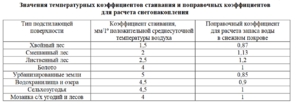Degree-day melting factor: различия между версиями
Перейти к навигации
Перейти к поиску

Valentina (обсуждение | вклад) |
Valentina (обсуждение | вклад) |
||
| Строка 5: | Строка 5: | ||
== Определение на английском == | == Определение на английском == | ||
| − | 1: It is measure of the departure of the mean temperature for a day from a given reference of O°C (32°F) temperature <ref>Bethan Davies Degree day models: Modelling glacier melt // AntarcticGlaciers. - 2020</ref>. | + | 1: It is measure of the departure of the mean temperature for a day from a given reference of O°C (32°F) temperature <ref name=":0">Bethan Davies Degree day models: Modelling glacier melt // AntarcticGlaciers. - 2020</ref>. |
2: is the amount of melt that occurs per positive degree day <ref>Glossary of Permafrost and Related Ground-Ice Terms. - 2005. - р. 159</ref>. | 2: is the amount of melt that occurs per positive degree day <ref>Glossary of Permafrost and Related Ground-Ice Terms. - 2005. - р. 159</ref>. | ||
| Строка 11: | Строка 11: | ||
== Пример использования термина на английском языке == | == Пример использования термина на английском языке == | ||
| − | # Melt rates per positive degree day vary geographically <ref | + | # Melt rates per positive degree day vary geographically <ref name=":0" />. |
# Melt (Degree-Day) Factors and Lapse Rates Utilized in Regionally Focused Glacier Modeling Studies <ref>Fernández A., Mark B.G. Modeling modern glacier response to climate changes along the Andes Cordillera: A multiscale review // Journal of Advances in Modeling Earth Systems. – 2016. – Vol. 8. – № 1. – p. 467-495.</ref>. | # Melt (Degree-Day) Factors and Lapse Rates Utilized in Regionally Focused Glacier Modeling Studies <ref>Fernández A., Mark B.G. Modeling modern glacier response to climate changes along the Andes Cordillera: A multiscale review // Journal of Advances in Modeling Earth Systems. – 2016. – Vol. 8. – № 1. – p. 467-495.</ref>. | ||
| − | # The concept of degree-day factor was first proposed by Finsterwalder and Schunk in 1887 for studying glacier changes, and was subsequently improved by many researchers | + | # The concept of degree-day factor was first proposed by Finsterwalder and Schunk in 1887 for studying glacier changes, and was subsequently improved by many researchers <ref>Zhou G., Cui M., Wan J., Zhang S. A Review on Snowmelt Models: Progress and Prospect // Sustainability. – 2021. – Vol. 13. – № 20. – p. 11485.</ref>. |
== Перевод использования на русском языке == | == Перевод использования на русском языке == | ||
Текущая версия на 06:50, 26 апреля 2024

Таблица температурных коэффициентов стаивания и поправочных коэффициентов [1]
Термин на русском
Температурный коэффициент стаивания - толщина слоя талой воды, приходящаяся на 1 градус Цельсия положительной температуры воздуха в сутки [2]
Определение на английском
1: It is measure of the departure of the mean temperature for a day from a given reference of O°C (32°F) temperature [3].
2: is the amount of melt that occurs per positive degree day [4].
Пример использования термина на английском языке
- Melt rates per positive degree day vary geographically [3].
- Melt (Degree-Day) Factors and Lapse Rates Utilized in Regionally Focused Glacier Modeling Studies [5].
- The concept of degree-day factor was first proposed by Finsterwalder and Schunk in 1887 for studying glacier changes, and was subsequently improved by many researchers [6].
Перевод использования на русском языке
- Коэффициент стаивания варьируется в зависимости от географического положения.
- Коэффициент стаивания и скорости его изменения используются в региональных исследованиях моделирования ледников.
- Идея применения коэффициента стаивания была впервые предложена Финстервальдером и Шунк в 1887 году для изучения изменений ледников и впоследствии была усовершенствована многими исследователями.
Список литературы
- ↑ Пьянков С.В., Шихов А.Н. Исследование динамики процессов снеготаяния методами геоинформационного моделирования (на примере территории Пермского края) // Вестник Удмуртского университета. Серия «Биология. Науки о Земле». 2013. №4.
- ↑ ГОСТ 26463-85 Ледники. Термины и определения, пункт 48
- ↑ Перейти обратно: 3,0 3,1 Bethan Davies Degree day models: Modelling glacier melt // AntarcticGlaciers. - 2020
- ↑ Glossary of Permafrost and Related Ground-Ice Terms. - 2005. - р. 159
- ↑ Fernández A., Mark B.G. Modeling modern glacier response to climate changes along the Andes Cordillera: A multiscale review // Journal of Advances in Modeling Earth Systems. – 2016. – Vol. 8. – № 1. – p. 467-495.
- ↑ Zhou G., Cui M., Wan J., Zhang S. A Review on Snowmelt Models: Progress and Prospect // Sustainability. – 2021. – Vol. 13. – № 20. – p. 11485.